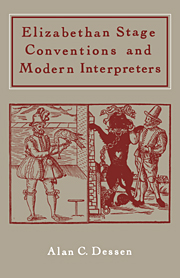Book contents
- Frontmatter
- Contents
- Preface
- Note on texts and old spelling
- 1 The arrow in Nessus: Elizabethan clues and modern detectives
- 2 Interpreting stage directions
- 3 The logic of ‘this’ on the open stage
- 4 Elizabethan darkness and modern lighting
- 5 The logic of ‘place’ and locale
- 6 The logic of stage violence
- 7 Theatrical metaphor: seeing and not-seeing
- 8 Conclusion: Elizabethan playscripts and modern interpreters
- Notes
- List of plays and editions
- Index
4 - Elizabethan darkness and modern lighting
Published online by Cambridge University Press: 22 September 2009
- Frontmatter
- Contents
- Preface
- Note on texts and old spelling
- 1 The arrow in Nessus: Elizabethan clues and modern detectives
- 2 Interpreting stage directions
- 3 The logic of ‘this’ on the open stage
- 4 Elizabethan darkness and modern lighting
- 5 The logic of ‘place’ and locale
- 6 The logic of stage violence
- 7 Theatrical metaphor: seeing and not-seeing
- 8 Conclusion: Elizabethan playscripts and modern interpreters
- Notes
- List of plays and editions
- Index
Summary
Put out the light, and then put out the light
(Othello, v. ii. 7)Gestic metaphors, hair about the ears, boots and safeguards, the arrow in Nessus – all represent components of that language of the theatre shared by dramatists, actors, and spectators then that may seem primitive, bizarre, or confusing today. Of the many such gaps between the original theatrical ‘logic’ and our familiar procedures perhaps the most revealing lies in the widely varying assumptions about on-stage night and darkness. For us, ‘going to the theatre’ (with the exception of outdoor matinees) means sitting in a darkened auditorium watching actors perform in a lighted space. In striking contrast, Shakespeare and his fellow dramatists wrote their plays for an auditorium in which (presumably) viewers could see each other as clearly as they could see the events on stage. The Elizabethan actors then presented their plays in light (whether natural, as at the Globe, or artificial, as at the Blackfriars) that essentially remained constant during the course of a performance, changing only when the sun moved behind a cloud or descended lower in the sky or when torches were carried on stage. In short, variable lighting, one of the essential tools for the modern director, was not available to the King's Men.
Nonetheless, night and darkness play an important part in many Elizabethan plays – for plot, imagery, and general atmosphere.
- Type
- Chapter
- Information
- Elizabethan Stage Conventions and Modern Interpreters , pp. 70 - 83Publisher: Cambridge University PressPrint publication year: 1984



